(All information courtesy of the instrument teams.)
![]() Previous IAU Circulars
Previous IAU Circulars
TITLE: GCN/SWIFT NOTICE
NOTICE_DATE: Fri 15 Dec 23 09:47:53 UT
NOTICE_TYPE: Swift-BAT GRB Position
TRIGGER_NUM: 1202522, Seg_Num: 0
GRB_RA: 9.750d {+00h 39m 00s} (J2000),
10.093d {+00h 40m 22s} (current),
9.038d {+00h 36m 09s} (1950)
GRB_DEC: +57.642d {+57d 38' 32"} (J2000),
+57.774d {+57d 46' 25"} (current),
+57.368d {+57d 22' 03"} (1950)
GRB_ERROR: 3.00 [arcmin radius, statistical only]
GRB_INTEN: 10731 [cnts] Image_Peak=232 [image_cnts]
TRIGGER_DUR: 2.048 [sec]
TRIGGER_INDEX: 271 E_range: 50-350 keV
BKG_INTEN: 38409 [cnts]
BKG_TIME: 35207.44 SOD {09:46:47.44} UT
BKG_DUR: 24 [sec]
GRB_DATE: 20293 TJD; 349 DOY; 23/12/15
GRB_TIME: 35245.27 SOD {09:47:25.27} UT
GRB_PHI: -174.19 [deg]
GRB_THETA: 57.17 [deg]
SOLN_STATUS: 0x20000003
RATE_SIGNIF: 98.44 [sigma]
IMAGE_SIGNIF: 9.55 [sigma]
MERIT_PARAMS: +1 +0 +0 +1 +3 +0 +0 +1 +47 +0
SUN_POSTN: 262.54d {+17h 30m 09s} -23.26d {-23d 15' 28"}
SUN_DIST: 118.80 [deg] Sun_angle= -7.2 [hr] (East of Sun)
MOON_POSTN: 297.95d {+19h 51m 49s} -26.11d {-26d 06' 23"}
MOON_DIST: 103.03 [deg]
MOON_ILLUM: 8 [%]
GAL_COORDS: 121.26, -5.19 [deg] galactic lon,lat of the burst (or transient)
ECL_COORDS: 38.47, 47.64 [deg] ecliptic lon,lat of the burst (or transient)
COMMENTS: SWIFT-BAT GRB Coordinates.
COMMENTS: This is a rate trigger.
COMMENTS: A point_source was found.
COMMENTS: This does not match any source in the on-board catalog.
COMMENTS: This does not match any source in the ground catalog.
COMMENTS: This is a GRB.
COMMENTS: This trigger occurred at longitude,latitude = 303.83,18.75 [deg].
COMMENTS:
COMMENTS: NOTE: This BAT event is temporally(8.0<100sec) coincident with the FERMI_GBM event (trignum=724326442).
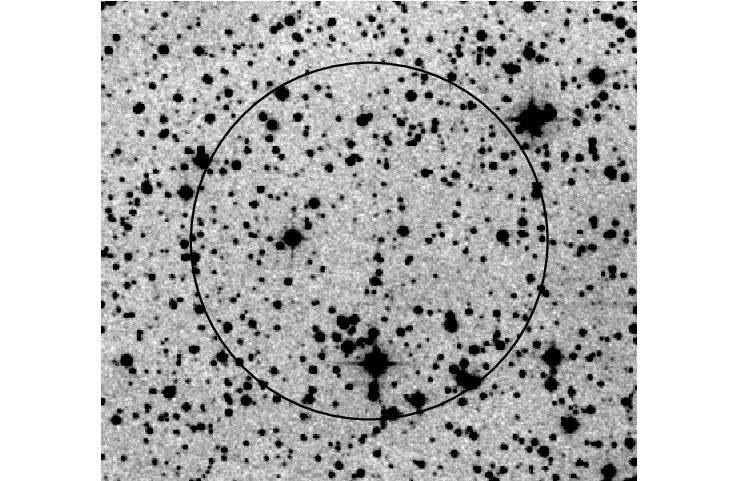
TITLE: GCN/FERMI NOTICE
NOTICE_DATE: Fri 15 Dec 23 09:47:56 UT
NOTICE_TYPE: Fermi-GBM Flight Position
RECORD_NUM: 59
TRIGGER_NUM: 724326442
GRB_RA: 243.950d {+16h 15m 48s} (J2000),
243.920d {+16h 15m 41s} (current),
244.016d {+16h 16m 04s} (1950)
GRB_DEC: +70.450d {+70d 27' 00"} (J2000),
+70.391d {+70d 23' 29"} (current),
+70.572d {+70d 34' 20"} (1950)
GRB_ERROR: 3.62 [deg radius, statistical plus systematic]
GRB_INTEN: 2753 [cnts/sec]
DATA_SIGNIF: 107.90 [sigma]
INTEG_TIME: 4.096 [sec]
GRB_DATE: 20293 TJD; 349 DOY; 23/12/15
GRB_TIME: 35237.81 SOD {09:47:17.81} UT
GRB_PHI: 204.00 [deg]
GRB_THETA: 155.00 [deg]
DATA_TIME_SCALE: 4.0960 [sec]
HARD_RATIO: 0.44
LOC_ALGORITHM: 3 (version number of)
MOST_LIKELY: 95% GRB
2nd_MOST_LIKELY: 4% Generic Transient
DETECTORS: 0,0,0, 0,0,0, 0,0,1, 0,0,1, 0,0,
SUN_POSTN: 262.54d {+17h 30m 09s} -23.26d {-23d 15' 28"}
SUN_DIST: 94.58 [deg] Sun_angle= 1.2 [hr] (West of Sun)
MOON_POSTN: 297.96d {+19h 51m 49s} -26.11d {-26d 06' 22"}
MOON_DIST: 103.74 [deg]
MOON_ILLUM: 8 [%]
GAL_COORDS: 103.61, 38.08 [deg] galactic lon,lat of the burst (or transient)
ECL_COORDS: 146.03, 79.79 [deg] ecliptic lon,lat of the burst (or transient)
LC_URL: http://heasarc.gsfc.nasa.gov/FTP/fermi/data/gbm/triggers/2023/bn231215408/quicklook/glg_lc_medres34_bn231215408.gif
COMMENTS: Fermi-GBM Flight-calculated Coordinates.
COMMENTS: This trigger occurred at longitude,latitude = 160.97,-2.42 [deg].
COMMENTS: The LC_URL file will not be created until ~15 min after the trigger.
COMMENTS:
COMMENTS: NOTE: This GBM event is temporally(8.0<100sec) coincident with the SWIFT_BAT event (trignum=1202522).
TITLE: GCN/FERMI NOTICE
NOTICE_DATE: Fri 15 Dec 23 09:48:06 UT
NOTICE_TYPE: Fermi-GBM Ground Position
RECORD_NUM: 58
TRIGGER_NUM: 724326442
GRB_RA: 11.220d {+00h 44m 53s} (J2000),
11.575d {+00h 46m 18s} (current),
10.485d {+00h 41m 56s} (1950)
GRB_DEC: +61.240d {+61d 14' 24"} (J2000),
+61.371d {+61d 22' 15"} (current),
+60.967d {+60d 57' 60"} (1950)
GRB_ERROR: 1.92 [deg radius, statistical only]
DATA_SIGNIF: 90.40 [sigma]
DATA_INTERVAL: 4.096 [sec]
GRB_DATE: 20293 TJD; 349 DOY; 23/12/15
GRB_TIME: 35237.81 SOD {09:47:17.81} UT
GRB_PHI: 225.00 [deg]
GRB_THETA: 114.00 [deg]
E_RANGE: 44.032 - 279.965 [keV]
LOC_ALGORITHM: 4173 (Gnd S/W Version number)
SUN_POSTN: 262.54d {+17h 30m 09s} -23.26d {-23d 15' 28"}
SUN_DIST: 119.35 [deg] Sun_angle= -7.3 [hr] (East of Sun)
MOON_POSTN: 297.96d {+19h 51m 50s} -26.11d {-26d 06' 21"}
MOON_DIST: 105.36 [deg]
MOON_ILLUM: 8 [%]
GAL_COORDS: 122.14, -1.62 [deg] galactic lon,lat of the burst (or transient)
ECL_COORDS: 42.64, 50.09 [deg] ecliptic lon,lat of the burst (or transient)
LC_URL: http://heasarc.gsfc.nasa.gov/FTP/fermi/data/gbm/triggers/2023/bn231215408/quicklook/glg_lc_medres34_bn231215408.gif
POS_MAP_URL: http://gcn.gsfc.nasa.gov/notices_f/gbm_gnd_loc_map_724326442.fits
COMMENTS: Fermi-GBM Ground-calculated Coordinates.
COMMENTS: Bright hard burst in the GBM.
COMMENTS: This Notice was ground-generated -- not flight-generated.
COMMENTS: The LC_URL file will not be created/available until ~15 min after the trigger.
COMMENTS: The POS_MAP_URL file will not be created/available until ~1.5 min after the notice.
COMMENTS:
COMMENTS: NOTE: This GBM event is temporally(8.0<100sec) coincident with the SWIFT_BAT event (trignum=1202522).
TITLE: GCN/FERMI NOTICE
NOTICE_DATE: Fri 15 Dec 23 09:47:47 UT
NOTICE_TYPE: Fermi-GBM Flight Position
RECORD_NUM: 46
TRIGGER_NUM: 724326442
GRB_RA: 243.300d {+16h 13m 12s} (J2000),
243.268d {+16h 13m 04s} (current),
243.370d {+16h 13m 29s} (1950)
GRB_DEC: +70.650d {+70d 39' 00"} (J2000),
+70.590d {+70d 35' 24"} (current),
+70.775d {+70d 46' 30"} (1950)
GRB_ERROR: 4.13 [deg radius, statistical plus systematic]
GRB_INTEN: 1182 [cnts/sec]
DATA_SIGNIF: 23.10 [sigma]
INTEG_TIME: 1.024 [sec]
GRB_DATE: 20293 TJD; 349 DOY; 23/12/15
GRB_TIME: 35237.81 SOD {09:47:17.81} UT
GRB_PHI: 204.00 [deg]
GRB_THETA: 155.00 [deg]
DATA_TIME_SCALE: 1.0240 [sec]
HARD_RATIO: 0.36
LOC_ALGORITHM: 3 (version number of)
MOST_LIKELY: 96% GRB
2nd_MOST_LIKELY: 3% Generic Transient
DETECTORS: 0,0,0, 0,0,0, 0,0,1, 0,0,1, 0,0,
SUN_POSTN: 262.54d {+17h 30m 09s} -23.26d {-23d 15' 28"}
SUN_DIST: 94.83 [deg] Sun_angle= 1.3 [hr] (West of Sun)
MOON_POSTN: 297.95d {+19h 51m 49s} -26.11d {-26d 06' 23"}
MOON_DIST: 104.04 [deg]
MOON_ILLUM: 8 [%]
GAL_COORDS: 103.97, 38.17 [deg] galactic lon,lat of the burst (or transient)
ECL_COORDS: 145.13, 79.55 [deg] ecliptic lon,lat of the burst (or transient)
LC_URL: http://heasarc.gsfc.nasa.gov/FTP/fermi/data/gbm/triggers/2023/bn231215408/quicklook/glg_lc_medres34_bn231215408.gif
COMMENTS: Fermi-GBM Flight-calculated Coordinates.
COMMENTS: This trigger occurred at longitude,latitude = 160.97,-2.42 [deg].
COMMENTS: The LC_URL file will not be created until ~15 min after the trigger.
COMMENTS:
COMMENTS: NOTE: This GBM event is temporally(2.0<100sec) coincident with the CALET_GBM event (trignum=1386668712).
TITLE: GCN/FERMI NOTICE
NOTICE_DATE: Fri 15 Dec 23 09:56:34 UT
NOTICE_TYPE: Fermi-GBM Final Position
RECORD_NUM: 0
TRIGGER_NUM: 724326442
GRB_RA: 11.060d {+00h 44m 14s} (J2000),
11.414d {+00h 45m 39s} (current),
10.326d {+00h 41m 18s} (1950)
GRB_DEC: +61.230d {+61d 13' 48"} (J2000),
+61.361d {+61d 21' 39"} (current),
+60.956d {+60d 57' 23"} (1950)
GRB_ERROR: 1.00 [deg radius, statistical only]
GRB_DATE: 20293 TJD; 349 DOY; 23/12/15
GRB_TIME: 35237.81 SOD {09:47:17.81} UT
GRB_PHI: 225.00 [deg]
GRB_THETA: 114.00 [deg]
E_RANGE: 44.032 - 279.965 [keV]
LOC_ALGORITHM: 41731 (Gnd S/W Version number)
SUN_POSTN: 262.54d {+17h 30m 11s} -23.26d {-23d 15' 29"}
SUN_DIST: 119.27 [deg] Sun_angle= -7.3 [hr] (East of Sun)
MOON_POSTN: 298.05d {+19h 52m 12s} -26.09d {-26d 05' 24"}
MOON_DIST: 105.23 [deg]
MOON_ILLUM: 8 [%]
GAL_COORDS: 122.07, -1.63 [deg] galactic lon,lat of the burst (or transient)
ECL_COORDS: 42.54, 50.13 [deg] ecliptic lon,lat of the burst (or transient)
LC_URL: http://heasarc.gsfc.nasa.gov/FTP/fermi/data/gbm/triggers/2023/bn231215408/quicklook/glg_lc_medres34_bn231215408.gif
LOC_URL: http://heasarc.gsfc.nasa.gov/FTP/fermi/data/gbm/triggers/2023/bn231215408/quicklook/glg_locplot_all_bn231215408.png
COMMENTS: Fermi-GBM Final Position.
COMMENTS: This Notice was ground-generated -- not flight-generated.
COMMENTS: The LC_URL file should be available by the time this FINAL notice is produced.
COMMENTS: This notice was generated completely by automated pipeline processing.
COMMENTS: Bright hard burst in the GBM.
COMMENTS: This is likely a Long GRB.
COMMENTS:
COMMENTS: NOTE: This GBM event is temporally(8.0<100sec) coincident with the SWIFT_BAT event (trignum=1202522).
TITLE: GCN/SWIFT NOTICE
NOTICE_DATE: Fri 15 Dec 23 09:51:27 UT
NOTICE_TYPE: Swift-BAT GRB Lightcurve
TRIGGER_NUM: 1202522, Seg_Num: 0
GRB_RA: 9.750d {+00h 39m 00s} (J2000),
10.093d {+00h 40m 22s} (current),
9.038d {+00h 36m 09s} (1950)
GRB_DEC: +57.642d {+57d 38' 32"} (J2000),
+57.774d {+57d 46' 25"} (current),
+57.368d {+57d 22' 03"} (1950)
GRB_DATE: 20293 TJD; 349 DOY; 23/12/15
GRB_TIME: 35245.27 SOD {09:47:25.27} UT
TRIGGER_INDEX: 271
GRB_PHI: -174.19 [deg]
GRB_THETA: 57.17 [deg]
DELTA_TIME: 58.00 [sec]
TRIGGER_DUR: 2.048 [sec]
SOLN_STATUS: 0x3
RATE_SIGNIF: 98.44 [sigma]
IMAGE_SIGNIF: 9.55 [sigma]
LC_URL: sw01202522000msb.lc
SUN_POSTN: 262.54d {+17h 30m 10s} -23.26d {-23d 15' 29"}
SUN_DIST: 118.80 [deg] Sun_angle= -7.2 [hr] (East of Sun)
MOON_POSTN: 297.99d {+19h 51m 58s} -26.10d {-26d 05' 59"}
MOON_DIST: 103.00 [deg]
MOON_ILLUM: 8 [%]
GAL_COORDS: 121.26, -5.19 [deg] galactic lon,lat of the burst (or transient)
ECL_COORDS: 38.47, 47.64 [deg] ecliptic lon,lat of the burst (or transient)
COMMENTS: SWIFT-BAT GRB Lightcurve.
COMMENTS:
COMMENTS: The next comments were copied from the BAT_POS Notice:
COMMENTS: This is a rate trigger.
COMMENTS: A point_source was found.
COMMENTS: This does not match any source in the on-board catalog.
COMMENTS: This does not match any source in the ground catalog.
COMMENTS: This is a GRB.
COMMENTS: This trigger occurred at longitude,latitude = 303.83,18.75 [deg].
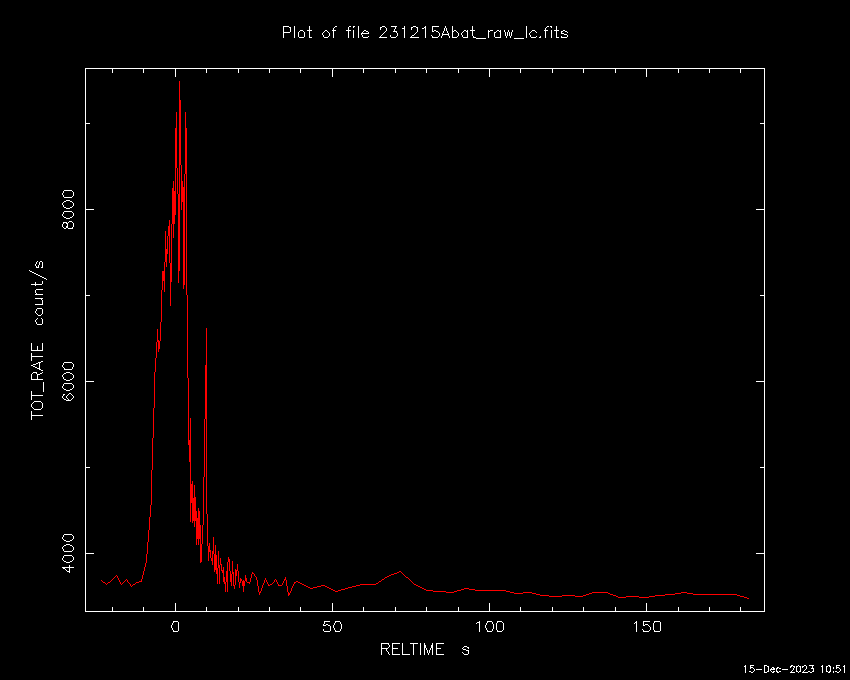
RA(J2000) = 00h 39m 00s Dec(J2000) = +57d 38' 32"with an uncertainty of 3 arcmin (radius, 90% containment, including systematic uncertainty). The BAT light curve showed a complex structure with a duration of about 30 sec. The peak count rate was ~6000 counts/sec (15-350 keV), at ~1 sec after the trigger.
TITLE: GCN/SWIFT NOTICE
NOTICE_DATE: Fri 15 Dec 23 10:33:30 UT
NOTICE_TYPE: Swift-XRT Image
TRIGGER_NUM: 1202522, Seg_Num: 0
GRB_RA: 9.7388d {+00h 38m 57.3s} (J2000),
10.0820d {+00h 40m 19.6s} (current),
9.0270d {+00h 36m 06.4s} (1950)
GRB_DEC: +57.6456d {+57d 38' 44.1"} (J2000),
+57.7770d {+57d 46' 37.0"} (current),
+57.3709d {+57d 22' 15.3"} (1950)
GRB_ERROR: 5.4 [arcsec, radius, statistical plus systematic]
GRB_INTEN: 24 [cnts]
IMG_START_DATE: 20293 TJD; 349 DOY; 23/12/15
IMG_START_TIME: 37971.00 SOD {10:32:51.00} UT, 2725.7 [sec] since BAT Trigger Time
CENTROID_X: 375.43, raw= 375 [pixels]
CENTROID_Y: 283.91, raw= 284 [pixels]
ROLL: 271.15 [deg]
GAIN: 2
MODE: 3, Long Image mode
WAVEFORM: 134
EXPO_TIME: 2.50 [sec]
GRB_POS_XRT_Y: -33.44
GRB_POS_XRT_Z: 160.37
IMAGE_URL: sw01202522000msxps_rw.img
SUN_POSTN: 262.57d {+17h 30m 17s} -23.26d {-23d 15' 34"}
SUN_DIST: 118.78 [deg] Sun_angle= -7.2 [hr] (East of Sun)
MOON_POSTN: 298.45d {+19h 53m 48s} -26.02d {-26d 01' 13"}
MOON_DIST: 102.72 [deg]
MOON_ILLUM: 8 [%]
GAL_COORDS: 121.26, -5.19 [deg] galactic lon,lat of the burst
ECL_COORDS: 38.47, 47.65 [deg] ecliptic lon,lat of the burst
COMMENTS: SWIFT-XRT Image.
COMMENTS: The object found at this position is either a very bright burst or a cosmic ray hit.
COMMENTS: Examine the XRT Image to differentiate (CRs are much more compact); see examples at:
COMMENTS: http://www.swift.psu.edu/xrt/XRT_Postage_Stamp_Image_Photo_Gallery.htm .

TITLE: GCN/SWIFT NOTICE
NOTICE_DATE: Fri 15 Dec 23 10:33:34 UT
NOTICE_TYPE: Swift-XRT Processed Image
TRIGGER_NUM: 1202522, Seg_Num: 0
GRB_RA: 9.7388d {+00h 38m 57.3s} (J2000),
10.0820d {+00h 40m 19.6s} (current),
9.0270d {+00h 36m 06.4s} (1950)
GRB_DEC: +57.6456d {+57d 38' 44.1"} (J2000),
+57.7770d {+57d 46' 37.0"} (current),
+57.3709d {+57d 22' 15.3"} (1950)
GRB_ERROR: 5.4 [arcsec, radius, statistical plus systematic]
GRB_INTEN: 24 [cnts]
IMG_START_DATE: 20293 TJD; 349 DOY; 23/12/15
IMG_START_TIME: 37971.00 SOD {10:32:51.00} UT, 2725.7 [sec] since BAT Trigger Time
CENTROID_X: 375.43, raw= 375 [pixels]
CENTROID_Y: 283.91, raw= 284 [pixels]
ROLL: 271.15 [deg]
GAIN: 2
MODE: 3, Long Image mode
WAVEFORM: 134
EXPO_TIME: 2.50 [sec]
GRB_POS_XRT_Y: -33.44
GRB_POS_XRT_Z: 160.37
IMAGE_URL: sw01202522000msxps_rw.img
SUN_POSTN: 262.57d {+17h 30m 17s} -23.26d {-23d 15' 34"}
SUN_DIST: 118.78 [deg] Sun_angle= -7.2 [hr] (East of Sun)
MOON_POSTN: 298.45d {+19h 53m 48s} -26.02d {-26d 01' 12"}
MOON_DIST: 102.72 [deg]
MOON_ILLUM: 8 [%]
GAL_COORDS: 121.26, -5.19 [deg] galactic lon,lat of the burst
ECL_COORDS: 38.47, 47.65 [deg] ecliptic lon,lat of the burst
COMMENTS: SWIFT-XRT Processed Image.
COMMENTS: The object found at this position is either a very bright burst or a cosmic ray hit.
COMMENTS: Examine the XRT Image to differentiate (CRs are much more compact); see examples at:
COMMENTS: http://www.swift.psu.edu/xrt/XRT_Postage_Stamp_Image_Photo_Gallery.htm .

TITLE: GCN/SWIFT NOTICE
NOTICE_DATE: Fri 15 Dec 23 10:33:21 UT
NOTICE_TYPE: Swift-XRT Position
TRIGGER_NUM: 1202522, Seg_Num: 0
GRB_RA: 9.7388d {+00h 38m 57.31s} (J2000),
10.0820d {+00h 40m 19.68s} (current),
9.0270d {+00h 36m 06.48s} (1950)
GRB_DEC: +57.6456d {+57d 38' 44.1"} (J2000),
+57.7770d {+57d 46' 37.0"} (current),
+57.3709d {+57d 22' 15.3"} (1950)
GRB_ERROR: 5.5 [arcsec radius, statistical plus systematic, 90% containment]
GRB_INTEN: 1.09e-09 [erg/cm2/sec]
GRB_SIGNIF: 4.89 [sigma]
IMG_START_DATE: 20293 TJD; 349 DOY; 23/12/15
IMG_START_TIME: 37971.00 SOD {10:32:51.00} UT, 2725.7 [sec] since BAT Trigger Time
TAM[0-3]: 327.66 237.13 261.67 243.69
AMPLIFIER: 2
WAVEFORM: 134
SUN_POSTN: 262.57d {+17h 30m 17s} -23.26d {-23d 15' 34"}
SUN_DIST: 118.78 [deg] Sun_angle= -7.2 [hr] (East of Sun)
MOON_POSTN: 298.45d {+19h 53m 48s} -26.02d {-26d 01' 14"}
MOON_DIST: 102.72 [deg]
MOON_ILLUM: 8 [%]
GAL_COORDS: 121.26, -5.19 [deg] galactic lon,lat of the burst
ECL_COORDS: 38.47, 47.65 [deg] ecliptic lon,lat of the burst
COMMENTS: SWIFT-XRT Coordinates.
COMMENTS: The XRT position is 0.41 arcmin from the BAT position.
COMMENTS: The object found at this position is either a very bright burst or a cosmic ray hit.
COMMENTS: Examine the XRT Image to differentiate (CRs are much more compact); see examples at:
COMMENTS: http://www.swift.psu.edu/xrt/XRT_Postage_Stamp_Image_Photo_Gallery.htm .
TITLE: GCN/SWIFT NOTICE
NOTICE_DATE: Fri 15 Dec 23 10:36:27 UT
NOTICE_TYPE: Swift-UVOT Source List
TRIGGER_NUM: 1202522, Seg_Num: 0
POINT_RA: 9.655d {+00h 38m 37s} (J2000)
POINT_DEC: +57.637d {+57d 38' 14"} (J2000)
POINT_ROLL: 271.154d
IMG_START_DATE: 20293 TJD; 349 DOY; 23/12/15
IMG_START_TIME: 37978.08 SOD {10:32:58.08} UT, 2732.8 [sec] since BAT Trigger Time
FILTER: 10, White
BKG_MEAN: 4.197
N_STARS: 190
X_OFFSET: 176 [pixels]
Y_OFFSET: 782 [pixels]
X_MAX: 1135 [pixels]
Y_MAX: 1741 [pixels]
DET_THRESH: 17
PHOTO_THRESH: 10
SL_URL: sw01202522000msufc2732.fits
SUN_POSTN: 262.57d {+17h 30m 18s} -23.26d {-23d 15' 35"}
SUN_DIST: 118.74 [deg] Sun_angle= -7.2 [hr] (East of Sun)
MOON_POSTN: 298.48d {+19h 53m 56s} -26.01d {-26d 00' 52"}
MOON_DIST: 102.65 [deg]
MOON_ILLUM: 8 [%]
GAL_COORDS: 121.21, -5.19 [deg] galactic lon,lat of the pointing direction
ECL_COORDS: 38.41, 47.67 [deg] ecliptic lon,lat of the pointing direction
COMMENTS: SWIFT-UVOT Source List.
TITLE: GCN/SWIFT NOTICE
NOTICE_DATE: Fri 15 Dec 23 10:36:42 UT
NOTICE_TYPE: Swift-UVOT Processed Source List
TRIGGER_NUM: 1202522, Seg_Num: 0
POINT_RA: 9.655d {+00h 38m 37s} (J2000)
POINT_DEC: +57.637d {+57d 38' 14"} (J2000)
POINT_ROLL: 271.154d
IMG_START_DATE: 20293 TJD; 349 DOY; 23/12/15
IMG_START_TIME: 37978.08 SOD {10:32:58.08} UT, 2732.8 [sec] since BAT Trigger Time
FILTER: 10, White
BKG_MEAN: 4.197
N_STARS: 190
X_OFFSET: 176 [pixels]
Y_OFFSET: 782 [pixels]
X_MAX: 1135 [pixels]
Y_MAX: 1741 [pixels]
DET_THRESH: 17
PHOTO_THRESH: 10
SL_URL: sw01202522000msufc2732.fits
SUN_POSTN: 262.57d {+17h 30m 18s} -23.26d {-23d 15' 35"}
SUN_DIST: 118.74 [deg] Sun_angle= -7.2 [hr] (East of Sun)
MOON_POSTN: 298.48d {+19h 53m 56s} -26.01d {-26d 00' 51"}
MOON_DIST: 102.65 [deg]
MOON_ILLUM: 8 [%]
GAL_COORDS: 121.21, -5.19 [deg] galactic lon,lat of the pointing direction
ECL_COORDS: 38.41, 47.67 [deg] ecliptic lon,lat of the pointing direction
COMMENTS: SWIFT-UVOT Processed Source List.
COMMENTS: All 4 attachments are included.
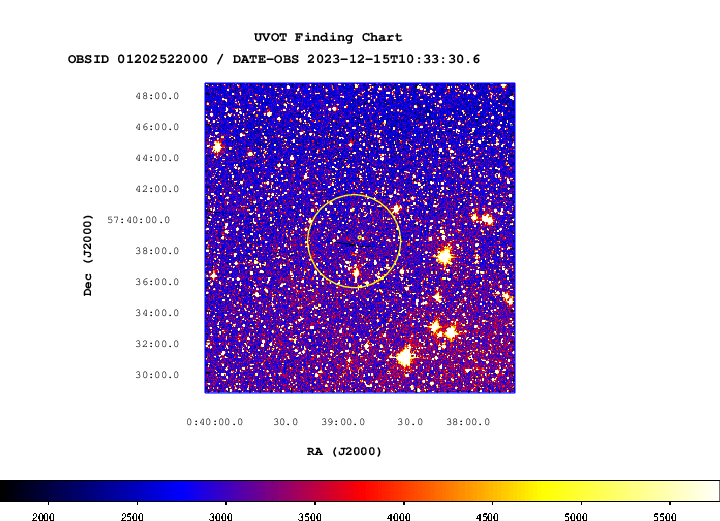
TITLE: GCN/SWIFT NOTICE
NOTICE_DATE: Fri 15 Dec 23 10:38:20 UT
NOTICE_TYPE: Swift-UVOT Image
TRIGGER_NUM: 1202522, Seg_Num: 0
POINT_RA: 9.655d {+00h 38m 37s} (J2000)
POINT_DEC: +57.637d {+57d 38' 14"} (J2000)
ROLL: 271.154d
IMG_START_DATE: 20293 TJD; 349 DOY; 23/12/15
IMG_START_TIME: 37978.08 SOD {10:32:58.08} UT, 2732.8 [sec] since BAT Trigger Time
FILTER: 10, White
EXPOSURE_ID: 724329210
X_OFFSET: 546 [pixels]
Y_OFFSET: 1102 [pixels]
WIDTH: 160 [pixels]
HEIGHT: 160 [pixels]
X_GRB_POS: 706
Y_GRB_POS: 1262
BINNING_INDEX: 1
IM_URL: sw01202522000msuni2765.fits
SUN_POSTN: 262.58d {+17h 30m 18s} -23.26d {-23d 15' 35"}
SUN_DIST: 118.73 [deg] Sun_angle= -7.2 [hr] (East of Sun)
MOON_POSTN: 298.50d {+19h 54m 01s} -26.01d {-26d 00' 39"}
MOON_DIST: 102.64 [deg]
MOON_ILLUM: 8 [%]
GAL_COORDS: 121.21, -5.19 [deg] galactic lon,lat of the pointing direction
ECL_COORDS: 38.41, 47.67 [deg] ecliptic lon,lat of the pointing direction
COMMENTS: SWIFT-UVOT Image.
COMMENTS: The GRB Position came from the XRT Position Command.
COMMENTS: The image has 2x2 binning (compression).
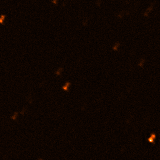
TITLE: GCN/SWIFT NOTICE
NOTICE_DATE: Fri 15 Dec 23 10:38:33 UT
NOTICE_TYPE: Swift-UVOT Processed Image
TRIGGER_NUM: 1202522, Seg_Num: 0
POINT_RA: 9.655d {+00h 38m 37s} (J2000)
POINT_DEC: +57.637d {+57d 38' 14"} (J2000)
ROLL: 271.154d
IMG_START_DATE: 20293 TJD; 349 DOY; 23/12/15
IMG_START_TIME: 37978.08 SOD {10:32:58.08} UT, 2732.8 [sec] since BAT Trigger Time
FILTER: 10, White
EXPOSURE_ID: 724329210
X_OFFSET: 546 [pixels]
Y_OFFSET: 1102 [pixels]
WIDTH: 160 [pixels]
HEIGHT: 160 [pixels]
X_GRB_POS: 706
Y_GRB_POS: 1262
BINNING_INDEX: 1
IM_URL: sw01202522000msuni2765.fits
SUN_POSTN: 262.58d {+17h 30m 18s} -23.26d {-23d 15' 35"}
SUN_DIST: 118.73 [deg] Sun_angle= -7.2 [hr] (East of Sun)
MOON_POSTN: 298.50d {+19h 54m 01s} -26.01d {-26d 00' 38"}
MOON_DIST: 102.64 [deg]
MOON_ILLUM: 8 [%]
GAL_COORDS: 121.21, -5.19 [deg] galactic lon,lat of the pointing direction
ECL_COORDS: 38.41, 47.67 [deg] ecliptic lon,lat of the pointing direction
COMMENTS: SWIFT-UVOT Processed Image.
COMMENTS: The GRB Position came from the XRT Position Command.
COMMENTS: The image has 2x2 binning (compression).
COMMENTS: All 4 attachments are included.
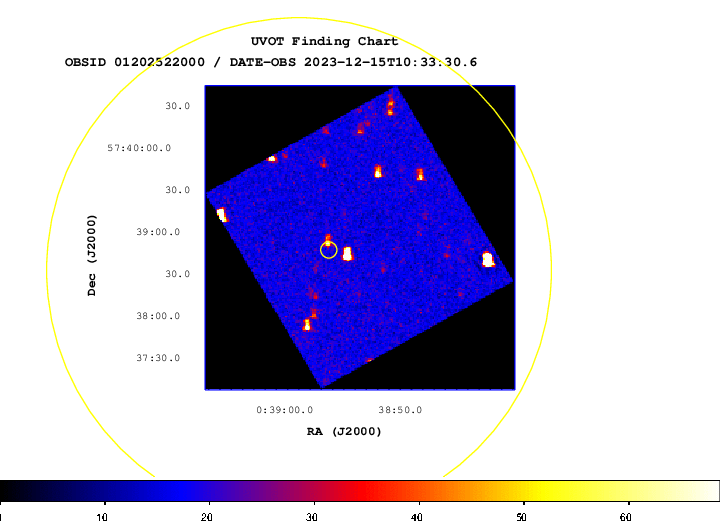
TITLE: GCN/SWIFT NOTICE
NOTICE_DATE: Fri 15 Dec 23 10:39:50 UT
NOTICE_TYPE: Swift-UVOT Position
TRIGGER_NUM: 1202522, Seg_Num: 0
GRB_RA: 9.7399d {+00h 38m 57.57s} (J2000),
10.0831d {+00h 40m 19.95s} (current),
9.0281d {+00h 36m 06.74s} (1950)
GRB_DEC: +57.6475d {+57d 38' 51.0"} (J2000),
+57.7789d {+57d 46' 43.9"} (current),
+57.3728d {+57d 22' 22.1"} (1950)
GRB_ERROR: 1.1 [arcsec radius, statistical only]
GRB_MAG: 18.82 +/- 0.40 [mag]
FILTER: 10, White
IMG_START_DATE: 20293 TJD; 349 DOY; 23/12/15
IMG_START_TIME: 37975.00 SOD {10:32:55.00} UT, 2729.7 [sec] since BAT Trigger Time
SUN_POSTN: 262.58d {+17h 30m 18s} -23.26d {-23d 15' 35"}
SUN_DIST: 118.78 [deg] Sun_angle= -7.2 [hr] (East of Sun)
MOON_POSTN: 298.52d {+19h 54m 04s} -26.01d {-26d 00' 29"}
MOON_DIST: 102.68 [deg]
MOON_ILLUM: 8 [%]
GAL_COORDS: 121.26, -5.18 [deg] galactic lon,lat of the burst (or transient)
ECL_COORDS: 38.47, 47.65 [deg] ecliptic lon,lat of the burst (or transient)
COMMENTS: SWIFT UVOT Position Notice.
COMMENTS: This Notice was ground-generated -- not flight-generated.
COMMENTS: The UVOT position is 6.8 arcsec from the XRT position.
COMMENTS: Result based on srclist data.
COMMENTS: Notice generated automatically.
RA(J2000) = 00h 38m 58.02s Dec(J2000) = +57d 38' 47.2"with an uncertainty of 3.6 arcseconds (radius, 90% containment). This location is 22 arcseconds from the BAT onboard position, within the BAT error circle. This position may be improved as more data are received; the latest position is available at https://www.swift.ac.uk/sper.
TITLE: GCN/SWIFT NOTICE
NOTICE_DATE: Fri 15 Dec 23 11:15:46 UT
NOTICE_TYPE: Swift-XRT Position UPDATE
TRIGGER_NUM: 1202522, Seg_Num: 0
GRB_RA: 9.7417d {+00h 38m 58.00s} (J2000),
10.0850d {+00h 40m 20.38s} (current),
9.0299d {+00h 36m 07.17s} (1950)
GRB_DEC: +57.6465d {+57d 38' 47.4"} (J2000),
+57.7779d {+57d 46' 40.3"} (current),
+57.3718d {+57d 22' 18.5"} (1950)
GRB_ERROR: 3.6 [arcsec radius, statistical plus systematic, 90% containment]
GRB_INTEN: 1.00e-10 [erg/cm2/sec]
GRB_SIGNIF: 10.00 [sigma]
IMG_START_DATE: 20293 TJD; 349 DOY; 23/12/15
IMG_START_TIME: 37982.00 SOD {10:33:02.00} UT, 2736.7 [sec] since BAT Trigger Time
TAM[0-3]: 100.00 100.00 100.00 100.00
AMPLIFIER: 1
WAVEFORM: 31
SUN_POSTN: 262.60d {+17h 30m 25s} -23.26d {-23d 15' 40"}
SUN_DIST: 118.77 [deg] Sun_angle= -7.2 [hr] (East of Sun)
MOON_POSTN: 298.91d {+19h 55m 38s} -25.94d {-25d 56' 20"}
MOON_DIST: 102.44 [deg]
MOON_ILLUM: 8 [%]
GAL_COORDS: 121.26, -5.18 [deg] galactic lon,lat of the burst
ECL_COORDS: 38.47, 47.65 [deg] ecliptic lon,lat of the burst
COMMENTS: SWIFT-XRT Coordinates.
COMMENTS: This Notice was ground-generated -- not flight-generated.
COMMENTS: This is an Update Notice -- the RA,Dec values herein supersede the previous XRT_POS Notice.
COMMENTS: TAM values, flux and significance fields are not valid.
COMMENTS: This position was automatically generated on the ground using
COMMENTS: Photon Counting data telemetered via TDRSS (SPER data).
COMMENTS: See http://www.swift.ac.uk/sper/docs.php for details.
COMMENTS: The probability that this is a serendipitous source in the
COMMENTS: SPER window is 0.58% < P(seren) < 1.1%.
Tmid-T0 | Site |Filt.| Expt. | Limit| Comment
_________|_____________________|_____|_______|______|________
2590 | MASTER-Tunka | C | 90 | 19.2 |
2625 | MASTER-Tunka | C | 160 | 19.3 | Coadd
2769 | MASTER-Tunka | C | 10 | 19.0 |
2779 | MASTER-Tunka | C | 30 | 19.4 | Coadd
2874 | MASTER-Tunka | C | 220 | 19.5 | Coadd
2783 | MASTER-Tunka | C | 10 | 19.1 |
2797 | MASTER-Tunka | C | 10 | 19.1 |
2816 | MASTER-Tunka | C | 20 | 19.4 |
2841 | MASTER-Tunka | C | 70 | 19.6 | Coadd
2840 | MASTER-Tunka | C | 20 | 19.3 |
2869 | MASTER-Tunka | C | 30 | 19.4 |
2903 | MASTER-Tunka | C | 30 | 19.4 |
2942 | MASTER-Tunka | C | 40 | 18.7 |
2991 | MASTER-Tunka | C | 50 | 18.9 |
3051 | MASTER-Tunka | C | 170 | 19.5 | Coadd
3050 | MASTER-Tunka | C | 60 | 19.6 |
3114 | MASTER-Tunka | C | 60 | 19.6 |
3178 | MASTER-Tunka | C | 60 | 19.6 |
3242 | MASTER-Tunka | C | 60 | 19.6 |
3306 | MASTER-Tunka | C | 60 | 19.5 |
3369 | MASTER-Tunka | C | 60 | 19.5 |
3433 | MASTER-Tunka | C | 60 | 19.6 |
3497 | MASTER-Tunka | C | 60 | 19.6 |
3561 | MASTER-Tunka | C | 60 | 19.6 |
3625 | MASTER-Tunka | C | 60 | 19.5 |
3688 | MASTER-Tunka | C | 60 | 19.5 |
3752 | MASTER-Tunka | C | 60 | 19.5 |
3816 | MASTER-Tunka | C | 60 | 19.5 |
3880 | MASTER-Tunka | C | 60 | 19.5 |
3944 | MASTER-Tunka | C | 60 | 19.6 |
4008 | MASTER-Tunka | C | 60 | 19.6 |
4071 | MASTER-Tunka | C | 60 | 19.6 |
4135 | MASTER-Tunka | C | 60 | 19.6 |
4200 | MASTER-Tunka | C | 60 | 19.6 |
4264 | MASTER-Tunka | C | 60 | 19.6 |
4328 | MASTER-Tunka | C | 60 | 19.1 |
4392 | MASTER-Tunka | C | 60 | 19.1 |
4455 | MASTER-Tunka | C | 60 | 19.1 |
4520 | MASTER-Tunka | C | 60 | 19.1 |
4583 | MASTER-Tunka | C | 60 | 19.1 |
4647 | MASTER-Tunka | C | 60 | 19.1 |
4711 | MASTER-Tunka | C | 60 | 19.1 |
4775 | MASTER-Tunka | C | 60 | 19.1 |
4839 | MASTER-Tunka | C | 60 | 19.1 |
4902 | MASTER-Tunka | C | 60 | 19.1 |
4966 | MASTER-Tunka | C | 60 | 19.1 |
5030 | MASTER-Tunka | C | 60 | 19.1 |
5094 | MASTER-Tunka | C | 60 | 19.1 |
5157 | MASTER-Tunka | C | 60 | 19.1 |
5221 | MASTER-Tunka | C | 60 | 19.1 |
5285 | MASTER-Tunka | C | 60 | 19.1 |
5349 | MASTER-Tunka | C | 60 | 19.1 |
5412 | MASTER-Tunka | C | 60 | 19.1 |
5476 | MASTER-Tunka | C | 60 | 19.1 |
5541 | MASTER-Tunka | C | 60 | 19.1 |
5605 | MASTER-Tunka | C | 60 | 19.1 |
5669 | MASTER-Tunka | C | 60 | 19.1 |
5732 | MASTER-Tunka | C | 60 | 19.1 |
5796 | MASTER-Tunka | C | 60 | 19.1 |
5860 | MASTER-Tunka | C | 60 | 19.1 |
5924 | MASTER-Tunka | C | 60 | 19.1 |
5987 | MASTER-Tunka | C | 60 | 19.1 |
6051 | MASTER-Tunka | C | 60 | 19.1 |
6115 | MASTER-Tunka | C | 60 | 19.1 |
6179 | MASTER-Tunka | C | 60 | 19.1 |
6243 | MASTER-Tunka | C | 60 | 19.1 |
6307 | MASTER-Tunka | C | 60 | 19.1 |
Filter C is a clear (unfiltred) band.
Date UT start t-T0 Exp. Filter OT Err.
(mid, days) (s)
2023-12-15 11:17:39 0.063363 1x120 R 17.42 0.07
The photometry is based on nearby USNO-B1.0 R2 stars.
T0+[sec] | MID-UT | T-EXP[sec] | magnitudes of aperture photometry ---------------------------------------------------------------------------------------------------------------- 238 | 2023-12-15 09:51:23 | 60 | g=E2=80=99=3D17.54+/-0.06, Rc=3D17.86+/-0.05, Ic=3D17.40+/-0.05 ---------------------------------------------------------------------------------------------------------------- T0+ : Elapsed time after the trigger T-EXP: Total Exposure timeThe magnitudes are consistent with Lipunov et al., GCN 35347 and Pankov et = al., GCN 35349. We are continuing to observe the candidate.
------------------------------------------------------------------------ | JD (mid) | t-t0 (hours) | Filter | Exposure (s) | Magnitude (AB) | ------------------------------------------------------------------------ | 2460294.07510789 | 4.008 | r' | 380 | 19.65 +/- 0.08 | | 2460294.08452486 | 4.248 | g' | 380 | 20.44 +/- 0.11 | ------------------------------------------------------------------------The results are consistent to the values reported by V.Lipunov et al., GCN Circ. 35347; N. Pankov et al., GCN Circ. 35349; M. Sasada et al., GCN Circ. 35351; J. An et al., GCN Circ. 35353. The magnitudes are calibrated against PanSTARRS DR1 (Chambers et al., 2016) and are not corrected for Galactic extinction.
RA (J2000): 00h 38m 57.50s Dec (J2000): +57d 38' 52.6"with an uncertainty of 2.2 arcsec (radius, 90% confidence).
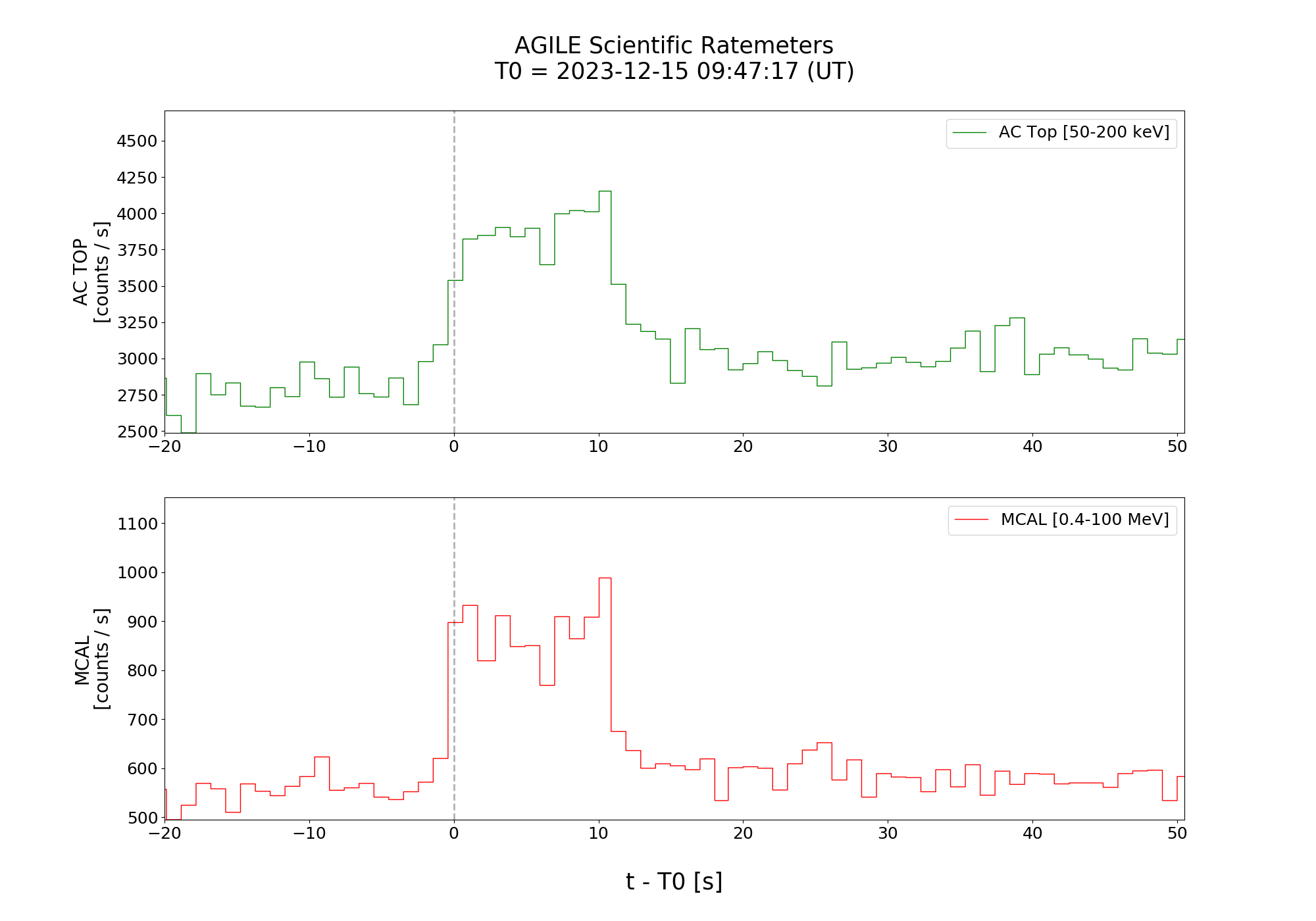
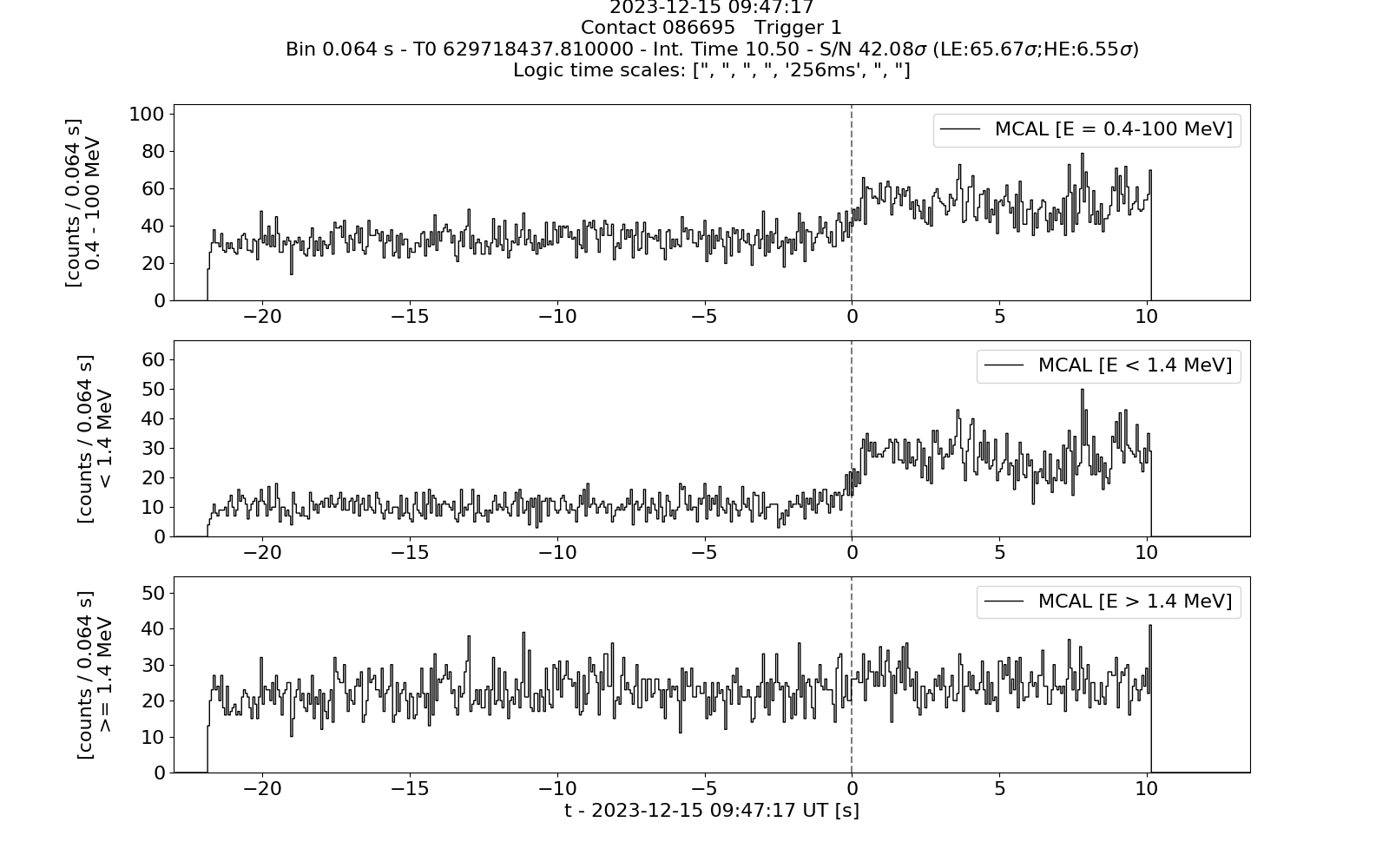
Total column: 4.40 (+1.19, -0.15) x 10^21 cm^-2 Galactic foreground: 4.2 x 10^21 cm^-2 Excess significance: <1.6 sigma Photon index: 1.89 (+0.20, -0.13)If the light curve continues to decay with a power-law decay index of 1.95, the count rate at T+24 hours will be 1.9 x 10^-3 count s^-1, corresponding to an observed (unabsorbed) 0.3-10 keV flux of 8.1 x 10^-14 (1.2 x 10^-13) erg cm^-2 s^-1.
RA (J2000) = 00:38:57.52 = 9.73967 (deg.)
Dec (J2000) = +57:38:50.5 = 57.64735 (deg.)
with an estimated uncertainty of 0.45 arc sec. (radius, 90% confidence).
Filter T_start(s) T_stop(s) Exp(s) Mag white 2733 2883 147 18.10 +/- 0.05 v 3713 3912 197 17.48 +/- 0.08 b 3096 3296 197 18.63 +/- 0.09 u 2891 3091 197 18.17 +/- 0.10 w1 4124 4323 197 19.57 +/- 0.31 m2 3918 4117 197 >19.4 w2 3507 3707 197 >19.5The magnitudes in the table are not corrected for the Galactic extinction due to the reddening of E(B-V) = 0.506 in the direction of the burst (Schlegel et al. 1998).
----------------------------------------------- T-T0 (in days, midtime) | mag | filter ----------------------------------------------- 0.3302 | 21.32 =C2=B1 0.10 mag (AB) | r' 0.3795 | 21.76 =C2=B1 0.07 mag (AB) | g' -----------------------------------------------The photometric calibration was performed using nearby stars from the PanST= ARRS catalog and magnitudes are not corrected for Galactic extinction.
Start T0+ End T0+ R lim 551 min 815 min 17,99We did not found any optical counterpart in 00:38:58.02 +57:38:47.2 positio= n and in the error box of the XRT candidate. ref.: P. D'Avanzo et al. GCN 35343, P.A. Evans et al. GCN 35345
RA(J2000) = 00h 38m 55.1s Dec(J2000) = +57d 38' 00.8"with an uncertainty of 1.3 arcmin, (radius, sys+stat, 90% containment). The partial coding was 6%. The mask-weighted light curve shows a structure of several overlapping pulses. The emission starts from T-10 s, peaks at T0 and ends at T+20 s. T90 (15-350 keV) is 20.75 +- 3.69 sec (estimated error including systematics). The time-averaged spectrum from T-7.04 to T+19.79 sec is best fit by a simple power-law model. The power law index of the time-averaged spectrum is 1.01 +- 0.09. The fluence in the 15-150 keV band is 1.0 +- 0.1 x 10^-5 erg/cm2. The 1-sec peak photon flux measured from T+0.18 sec in the 15-150 keV band is 9.6 +- 1.4 ph/cm2/sec. All the quoted errors are at the 90% confidence level. The results of the batgrbproduct analysis are available at http://gcn.gsfc.nasa.gov/notices_s/1202522/BA/
Start T0+ End T0+ Rlim 16:28:50 UT 17:08:29 UT 20We did not found any optical counterpart in the error box of the XRTcandidate. P. D'Avanzo et al. GCN 35343
RA: 00:38:57.53 +- 0.05 Dec: +57:38:50.7 +- 0.6The surface brightness peak is 61 uJy/beam and 128 uJy/beam at 6 and 10 GHz, respectively. The r.m.s. noise level of the images is 7 uJy/beam at both 6 and 10 GHz.
================================================================ T_mid Freq Peak r.m.s. Beam PA [days] [GHz] [uJy/b] [uJy/b] [arcsec] [deg] ================================================================ 12.7 6 110 8 11.69x9.50 -44 12.7 10 127 7 7.06x5.79 -33 32.7 6 48 7 7.34x4.23 -31 32.7 10 62 6 5.27x3.13 -24 ================================================================We would like to thank the staff of the VLA for approving, executing, and processing the observations.